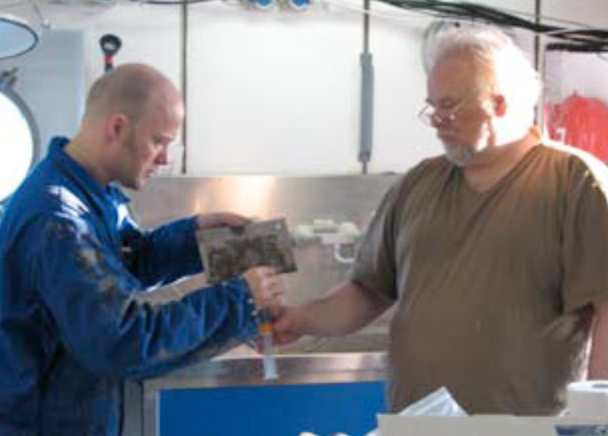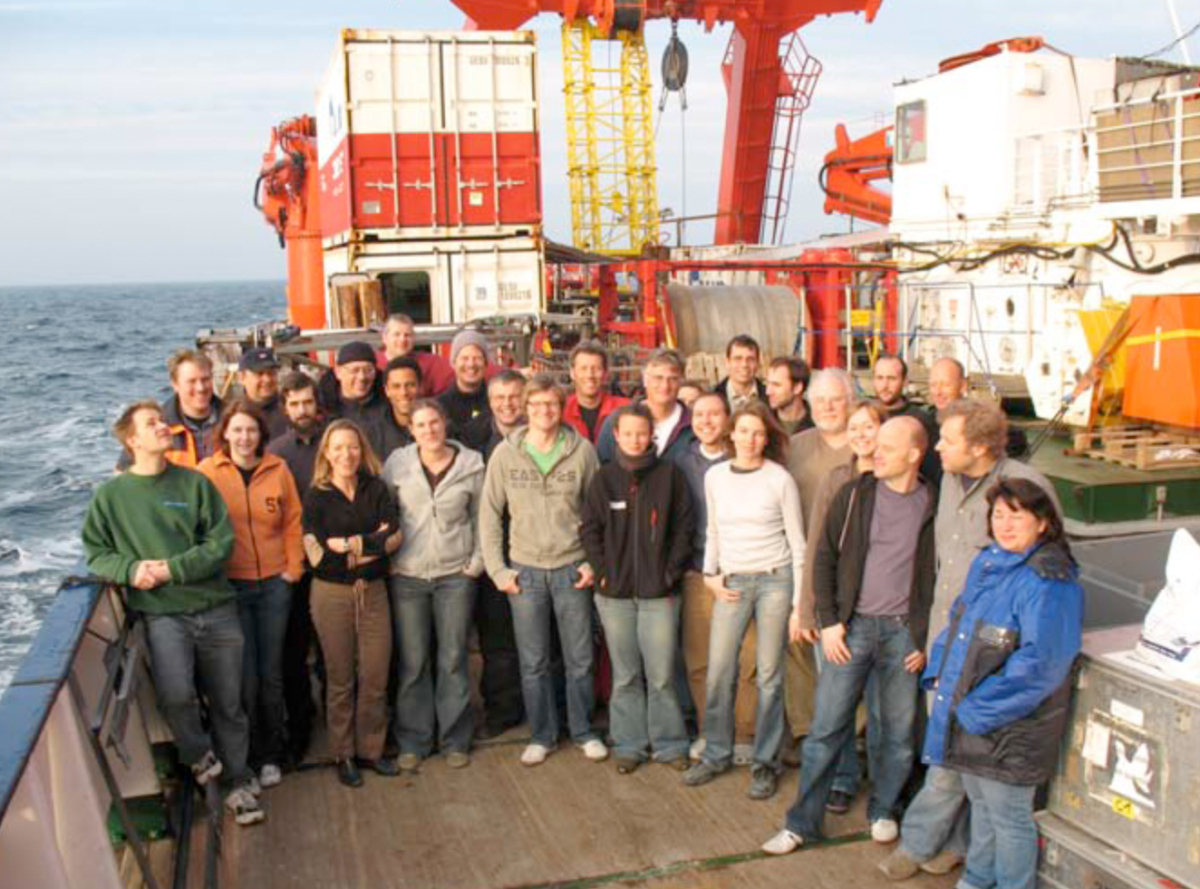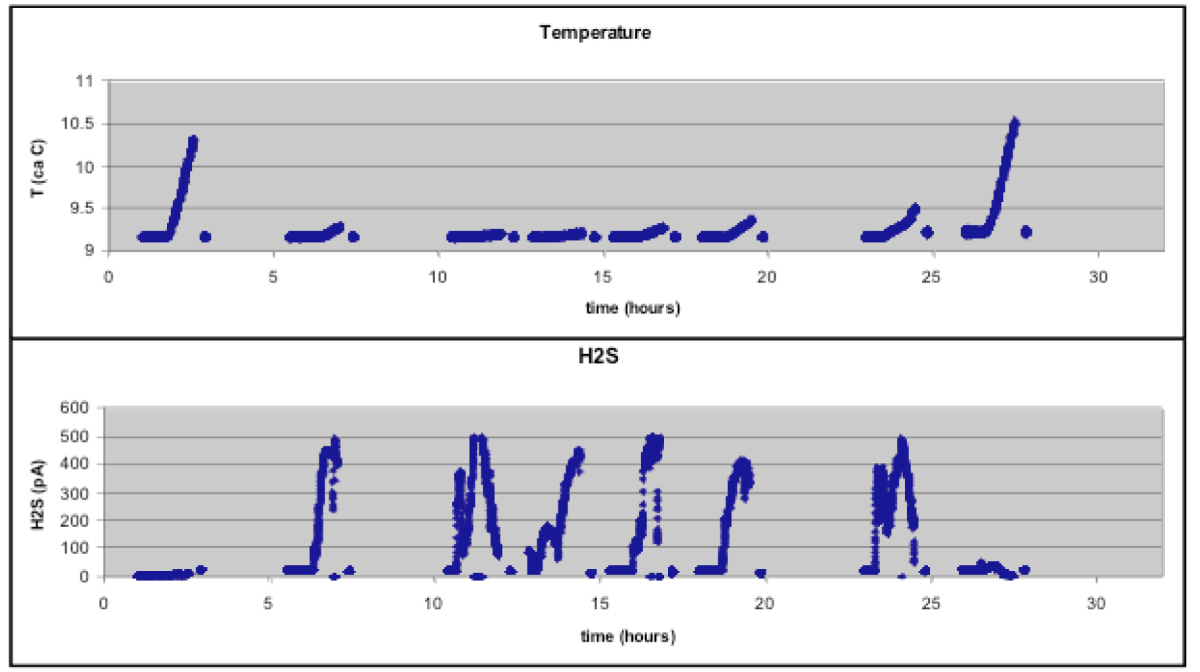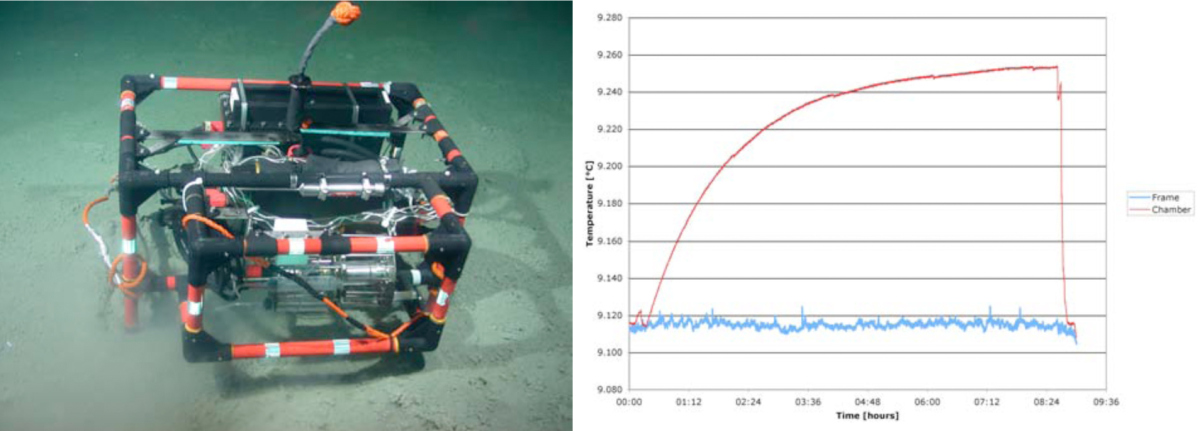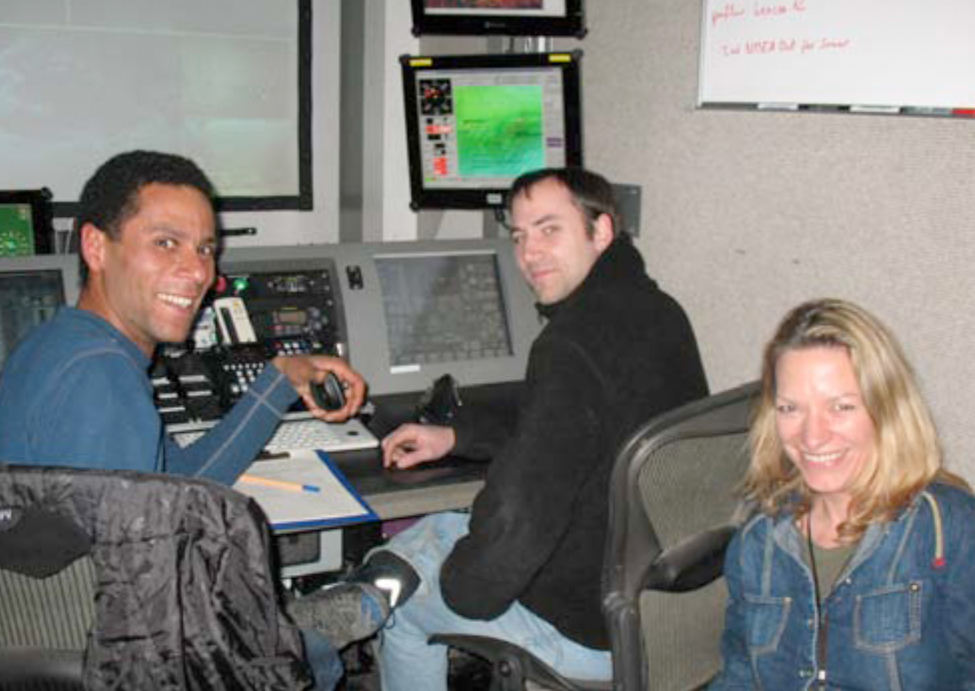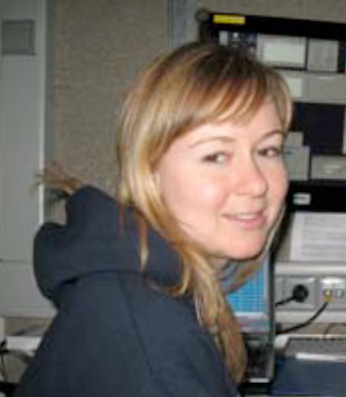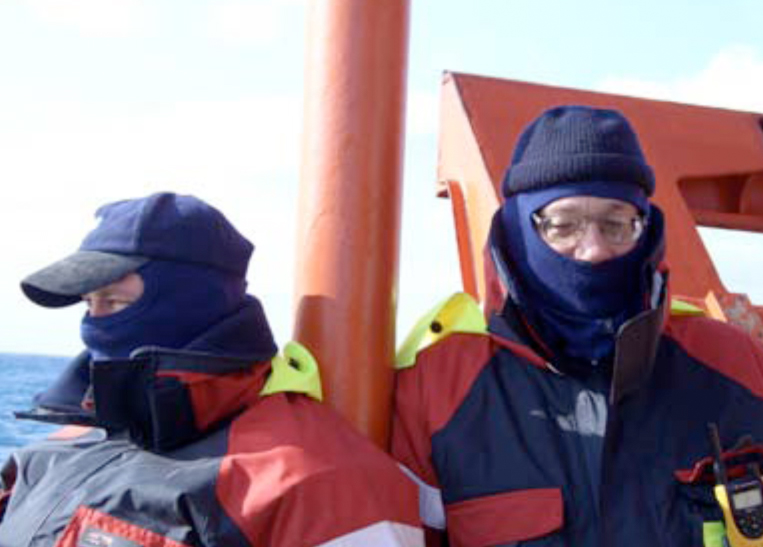Seitenpfad:
- Presse
- Pressemeldungen 2007
- Meteor M72/2
Meteor M72/2
The second week of the expedition M72/2 started with an extremely exciting dive of the deep- water robot QUEST. The 150st dive of QUEST broke several records at once: it lasted 32 hours and 20 minutes,resulted in 72 microsensor profiles, 23 in situ temperature probe measurements and 10 pages Alamer dive report. And no, this was not a tour the force commanded by the chief scientist known for her immense sampling appetite– it was the practical decision of the QUEST team leader to avoid a recovery procedure at Beaufort 9. The Black Sea is full of surprises, among which are unpredictable storms that may last for 24 hours and then vanish as rapidly as they have started. This was the situation on the 4th March: the well-prepared dive protocol suggested a modest 3 profiler deployments and recovery after 11 hours bottom time at 08:00 in the morning of the 5th March. Facing 4 m high waves, the brave ROV team offered acontinuous dive program asa birthday present to the chief scientist who had just turned 40. This unwanted change of the station plan (and birthday party scheduling) resulted in a beautiful data set on geosphere-biosphere interaction: One of our mainscientific questions on the MICROHAB cruise is asto the influence of subsurface fluid flow velocity on microbial activity, especially with regard toconsumption of the greenhouse gas methane.
We use temperature and sediment geochemistry as indicators of fluid flow rates. At the summit of the Dvurechenski mud volcano a temperature anomaly indicates high upward flow rates of sulfate depleted, warm fluids suppressing the formation of gas hydrates at 2000 m water depth. With temperature probing and microsensor deployments (measuring sulfide as a product of microbial methane consumption), we carried out a transect from the active warm summit across the geographical center of the mud volcano to its Western Rim and back to the summit. Fig. 1 shows the negative correlation between temperature increase in the sediments (related to fluid flow velocity) and sulfide production by the methanotrophic consortia in the sediments.
In areas with high fluid flow rates the methanotrophs are flushed with sulfate-free subsurface water and methane passes from the deep to the hydrosphere. In the case of the Dvurechenski MV the warm summit is loaded with free gas bubbles, which are released upon minor pressure changes. Microbes cannot profit from this potential energy source because of their limitation in the electron acceptor sulfate. The muds and fluids of the summit are so warm that temperature increased significantly in the benthic chamber we deployed to measure methane flux from the seafloor to the hydrosphere on the DMV summit (Fig. 2). The benthic chamber encloses 250 cm2 sediment. In parallel to the substantial temperature increase, methane concentrations increased by an order of magnitude within 8 hrs compared to the surrounding bottom water.
Before we left the Dvurechenski mud volcano we deployed successfully a long-term subsurface temperature observatory (Fig. 3) similar to the one previously deployed by the fluid flow- working group of IFREMER-AWI at Haakon Mosby mud volcano. One temperature logger will be retrieved in a month from now by the working group of Gerhard Bohrmann (RCOM Bremen; M72/3), another one when we return in 2009. Another long term experiment is the deployment of wood for the future observation of its microbial degradation under anoxic conditions in comparison to the animal-microbe mediated degradation in oxic deep-sea habitats where the wood often attracts a high diversity of unique species – but also relatives of chemosynthetic animals as they are found at vents and seeps (project DIWOOD).
We use temperature and sediment geochemistry as indicators of fluid flow rates. At the summit of the Dvurechenski mud volcano a temperature anomaly indicates high upward flow rates of sulfate depleted, warm fluids suppressing the formation of gas hydrates at 2000 m water depth. With temperature probing and microsensor deployments (measuring sulfide as a product of microbial methane consumption), we carried out a transect from the active warm summit across the geographical center of the mud volcano to its Western Rim and back to the summit. Fig. 1 shows the negative correlation between temperature increase in the sediments (related to fluid flow velocity) and sulfide production by the methanotrophic consortia in the sediments.
In areas with high fluid flow rates the methanotrophs are flushed with sulfate-free subsurface water and methane passes from the deep to the hydrosphere. In the case of the Dvurechenski MV the warm summit is loaded with free gas bubbles, which are released upon minor pressure changes. Microbes cannot profit from this potential energy source because of their limitation in the electron acceptor sulfate. The muds and fluids of the summit are so warm that temperature increased significantly in the benthic chamber we deployed to measure methane flux from the seafloor to the hydrosphere on the DMV summit (Fig. 2). The benthic chamber encloses 250 cm2 sediment. In parallel to the substantial temperature increase, methane concentrations increased by an order of magnitude within 8 hrs compared to the surrounding bottom water.
Before we left the Dvurechenski mud volcano we deployed successfully a long-term subsurface temperature observatory (Fig. 3) similar to the one previously deployed by the fluid flow- working group of IFREMER-AWI at Haakon Mosby mud volcano. One temperature logger will be retrieved in a month from now by the working group of Gerhard Bohrmann (RCOM Bremen; M72/3), another one when we return in 2009. Another long term experiment is the deployment of wood for the future observation of its microbial degradation under anoxic conditions in comparison to the animal-microbe mediated degradation in oxic deep-sea habitats where the wood often attracts a high diversity of unique species – but also relatives of chemosynthetic animals as they are found at vents and seeps (project DIWOOD).
The transit around the Crimean peninsula to the seeps on the NW Crimean shelf at 240 m gave us finally some time to celebrate. And then another one of the birthday wishes came true...
The last 4 days of the cruise were dedicated to in situ measurements of sulfide fluxes and methane consumption in the microbial reefs at the gas seeps on the Crimean shelf. We managed three 12 hour dives with QUEST and worked both at the GHOSTDABS field discovered by scientists of the University Hamburg in 2001 as well as at the close-by METROL field discovered by the EU project METROL in 2004. The sidescan sonar of ROV QUEST was used to map the fields and the distributions of chimneys, which reach from a few cm above bottom to 4 m in height. The microbial reefs are the largest and densest accumulations of microbes known on earth and consist of methanotrophic archaea and a variety of associated bacteria. Anaerobic methane consumption does not result in a large energy yield, hence, growth of microbes is extremely slow. A rough estimate suggests that the large chimneys may be a few 1000 years old. Unfortunately, large areas of these unique microbial reefs have been destroyed, probably by benthic trawling, which makes one wonder about the establishment of marine protected areas even for microbes.
We are now finished with station work and steaming back to Istanbul. It is good to be done and go home, but also a bit sad to leave without all of our goals achieved, despite the hard work of the French and German robot teams who gave their best to
provide dive time. Definitely we would like to come back to continue with in situ biogeochemical and ecological investigations of the Sorokin Trough mud volcanoes and other interesting seeps of the Black Sea as soon as possible!
For now we thank the captain and crew of METEOR for all their excellent help and support and send our best greetings to all friends and colleagues at home,
the MICROHAB team.
The last 4 days of the cruise were dedicated to in situ measurements of sulfide fluxes and methane consumption in the microbial reefs at the gas seeps on the Crimean shelf. We managed three 12 hour dives with QUEST and worked both at the GHOSTDABS field discovered by scientists of the University Hamburg in 2001 as well as at the close-by METROL field discovered by the EU project METROL in 2004. The sidescan sonar of ROV QUEST was used to map the fields and the distributions of chimneys, which reach from a few cm above bottom to 4 m in height. The microbial reefs are the largest and densest accumulations of microbes known on earth and consist of methanotrophic archaea and a variety of associated bacteria. Anaerobic methane consumption does not result in a large energy yield, hence, growth of microbes is extremely slow. A rough estimate suggests that the large chimneys may be a few 1000 years old. Unfortunately, large areas of these unique microbial reefs have been destroyed, probably by benthic trawling, which makes one wonder about the establishment of marine protected areas even for microbes.
We are now finished with station work and steaming back to Istanbul. It is good to be done and go home, but also a bit sad to leave without all of our goals achieved, despite the hard work of the French and German robot teams who gave their best to
provide dive time. Definitely we would like to come back to continue with in situ biogeochemical and ecological investigations of the Sorokin Trough mud volcanoes and other interesting seeps of the Black Sea as soon as possible!
For now we thank the captain and crew of METEOR for all their excellent help and support and send our best greetings to all friends and colleagues at home,
the MICROHAB team.
Fig. 5 The unique methanotrophic reefs of the Black Sea. Left: Gas sampling above a microbial chimney. Right: in
situ profiling of sulfide fluxes and pH with the horizontal microprofiler. Center: Two microbiologists sharing insight
into anoxic microbial habitats: Thomas Holler of MPI and Barry Cragg of the University of Cardiff . Right: The MICROHAB Team.
situ profiling of sulfide fluxes and pH with the horizontal microprofiler. Center: Two microbiologists sharing insight
into anoxic microbial habitats: Thomas Holler of MPI and Barry Cragg of the University of Cardiff . Right: The MICROHAB Team.
Fig. 1. The transect of dive 150 started and ended at the warm summit of the DMV, which shows the highest temperature anomalies in the sediments, but no sulfide production. In contrast, microbial methane consumption is very high at the geographical center (sampled at hour 7 and hour 24 of the dive) and at the rim (other measurements).
Fig. 2. The benthic chamber deployed at the summit of the Dvurechenski mud volcano. Right: The temperature
record of within (red) and outside (blue) the chamber.
record of within (red) and outside (blue) the chamber.
Fig. 3 Top: The long term temperature observatory deployed at the center of Dvurechenski mud volcano.
Large image: the 2 temperature loggers recording subsurface temperature measurements every 70 cm down to 6 m sediment depth. Small image: the mooring with the submerged gravity core and the float with the temperature loggers 5 m in the water column.
Bottom: the wood colonization deployment of project DIWOOD
Large image: the 2 temperature loggers recording subsurface temperature measurements every 70 cm down to 6 m sediment depth. Small image: the mooring with the submerged gravity core and the float with the temperature loggers 5 m in the water column.
Bottom: the wood colonization deployment of project DIWOOD
Fig. 4.Top:...an all MPI dive shift:
Marc Viehweger at the arm,
Patrick Meyer flying. middle: Laura Wehrmann writing the dive protocol and recently turned 40 Antje Boetius happy.
Bottom: ...ok, not all MPI, there are still some masked experts at the winch closely paying attention. From left to right: Phillip Franke and the QUEST team leader Götz Ruhland, both of MARUM.
Marc Viehweger at the arm,
Patrick Meyer flying. middle: Laura Wehrmann writing the dive protocol and recently turned 40 Antje Boetius happy.
Bottom: ...ok, not all MPI, there are still some masked experts at the winch closely paying attention. From left to right: Phillip Franke and the QUEST team leader Götz Ruhland, both of MARUM.


